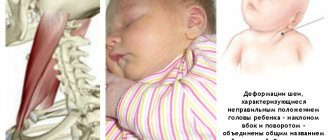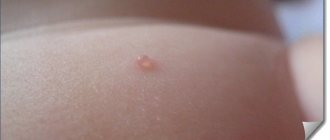Causes of diathesis in children
Since diathesis in newborns is an inadequate response to ordinary stimuli, its causes should be sought in a violation of metabolic or immune processes in the body. Often the anomaly is genetic in nature, but more often it occurs during the mother’s pregnancy.
The cause of diathesis in an infant may be:
- the pregnant woman has chronic pathologies that require constant use of special medications;
- unbalanced nutrition of the expectant mother, adherence to strict diets or, conversely, excessive infatuation with unhealthy foods (chocolate, citrus fruits, eggs, processed foods);
- use of potent antibiotics during pregnancy;
- non-compliance with the daily routine, stress, overwork;
- drinking alcohol, smoking, drug addiction;
- toxicosis.
Disorders inherent in the prenatal period begin to actively manifest themselves under the influence of predisposing factors. One of these moments may be the lack of breastfeeding or the early transfer of the baby to artificial nutrition. The health of newborns is very adversely affected by poor ecology in the place of residence.
Diathesis during breastfeeding, as a rule, indicates poor nutrition of the mother or unsuitable complementary feeding for the child. Often, a baby has a violent allergic reaction to washing powders, fabric softeners, and dyes on toys or clothes.
It is impossible to name the exact cause of diathesis in an infant. As a rule, an abnormal reaction of the body develops due to an unfavorable combination of several factors, the main of which are heredity and errors in nutrition.
Types of diathesis
In medical practice, it is customary to distinguish the following types of diathesis:
- exudative-catarrhal. The most common type of illness, which is characterized by allergic skin reactions and damage to the mucous membranes;
- lymphatic-hypoplastic diathesis. Develops against the background of metabolic disorders;
- neuro-arthritic. It manifests itself as a malfunction of the central nervous system and individual organs.
Any of these varieties can develop in an infant from the first month of life.
In what areas of the body does diathesis appear?
In young children, diathesis most often manifests itself on the cheeks and in the diaper area, although it can also be localized in other places:
- around the mouth;
- on the limbs: on the legs, arms, in particular on the elbow;
- under the hair and behind the ears.
Diathesis on the hands manifests itself in the elbow bends, in the area of the wrist, hand and fingers. Diaper rash may appear in the armpit folds. Diathesis on the legs is found in the groin area, popliteal area and feet. If the reaction is severe, redness and peeling may spread throughout the body and, in particular, on the abdomen. This condition is dangerous due to extensive swelling, so it must be treated in a hospital.
Symptoms of the disease
You can understand that a child has diathesis by the following characteristic signs:
- Diaper rash that lingers on the skin for a long time. The main places of localization are the groin, parotid region, as well as the bends of the arms;
- Dense scaly scabs that appear on the cheeks;
- Seborrhea rash on the face and head. It can be distinguished by its beige shade and loose structure. This rash goes away quickly, but tends to return frequently;
- Eczema, which manifests itself as skin cracks;
- Formation of a large number of small, colorless bubbles throughout the body.
Redness on the cheeks never goes away on its own. To eliminate them, it is necessary to exclude allergenic foods from the diet, and also to be treated with the necessary medications, which are prescribed only by a pediatrician.
Symptoms of diathesis also appear on the mucous membranes of the child:
- Conjunctivitis - inflammation of the mucous membrane of the eye;
- Rhinitis is a disease of the nasal mucosa, resulting in the formation of large mucus secretions;
- Inflammation of the mucous membrane of the throat, causing a cough;
- Failure of the normal functioning of the digestive tract, which is accompanied by nausea, vomiting and regular diarrhea;
In addition, diathesis is characterized by the manifestation of other, general symptoms:
- Decreased appetite, constant refusal to eat in a newborn;
- Permanent attacks of anxiety in a child, manifested by crying;
- Regurgitation that occurs more often than usual;
- Restless sleep.
Symptoms of diathesis
What does diathesis look like in infants? The symptoms of the disease are very diverse and manifest themselves in different ways. Each type of anomaly has its own unique features and characteristic features. However, there are also general signs of diathesis in children :
- constant anxiety, causeless crying, whims;
- child's refusal to eat;
- frequent regurgitation of the baby;
- baby's sleep disturbance.
Unlike local ones, general signs of anomaly are of a generalized nature, that is, they do not depend on the type of ailment and the location of inflammation.
Symptoms of exudative-catarrhal diathesis
This type of diathesis manifests itself from the age of one month and lasts up to 2 years. Later, it most often disappears without a trace. Skin symptoms include peeling, diaper rash, redness and irritation, itching, and thickening of the upper layer of the dermis on the cheeks (milky crust). Possible addition of eczema.
Symptoms of diathesis on the scalp appear as large yellowish scales. Damage to the mucous membrane is reflected in frequent inflammation of the oral cavity, diseases of the organs of vision and persistent respiratory tract infections.
Symptoms of lymphatic-hypoplastic diathesis
Metabolic diathesis in infants manifests itself at the age of two. It develops in approximately 10% of babies and is a hereditary anomaly.
Signs of lymphatic-hypoplastic lesion:
- enlarged lymph nodes;
- dysfunction of the adrenal glands;
- pallor of the dermis;
- lethargy, lethargy;
- late speech acquisition;
- puffiness of the face;
- proliferation of lymphoid tissues;
- distribution of subcutaneous fat according to female type.
The development of the lymphatic-hypoplastic form in children under one year of age almost always indicates a tendency to bronchial asthma and allergies.
Symptoms of neuro-arthritic diathesis
Neuro-arthritic diathesis in a child is accompanied by hyperexcitability, rapid depletion of the central nervous system, imbalance, and frequent whims. Often such children experience acetonemic crises, which occur after overexertion or prolonged fasting.
In infants, the symptoms of neuro-arthritic diathesis are very mild. The developmental anomaly is fully formed only by school and reveals itself as dermatitis, joint and nerve damage.
Consequences of the disease and prognosis
Since diathesis is not a disease, it is not dangerous in itself. But its consequences can negatively affect the baby’s health. So, what can this disease entail?
- frequent infectious diseases associated with a weakened child’s immune system;
- weight gain leading to obesity;
- rickets, anemia and leukemia;
- allergic diseases;
- disruption of the digestive system, in particular the formation of gastritis and ulcers.
ECD is a type of disease that can lead to serious consequences in the form of eczema, for example.
Neuro-arthritic diathesis entails health problems in adolescence. During this period, skin problems worsen, diabetes mellitus appears, kidney dysfunction develops, and obesity occurs.
If you correctly follow the measures to combat diathesis, the outcome of treatment is more likely to be favorable. By adolescence, the disease disappears completely.
In the presence of lymphatic-hypoplastic diathesis, the probability of death in children under one year of age is only 10%.
Diagnosis of diathesis in a child
With exudative-catarrhal and metabolic diathesis, diagnosis is not difficult. It is much more difficult to identify a neuroarthritic developmental anomaly.
To ensure the reliability of the results, the following procedures are prescribed to the sick baby:
- general blood and urine analysis;
- blood biochemistry;
- immunogram;
- stool analysis.
If lymphatic-hypoplastic diathesis is suspected in an infant, an ultrasound of the lymph nodes and thymus gland is additionally prescribed, and an x-ray is taken.
Treatment of diathesis in infants
How to treat diathesis in young children? If the mother was breastfeeding her baby, she should reconsider her diet and switch to a hypoallergenic diet. In addition, to eliminate disturbing symptoms and quickly cleanse the skin, you should resort to medications, but only after the doctor’s permission.
Drug treatment
How to cure diathesis with tablets and ointments? First of all, children are prescribed 1st generation antihistamines, which effectively eliminate itching and have a sedative effect: Suprastin, Diazolin, Fenkarol, Tavegil.
In addition to antiallergic drugs, the following groups of drugs are prescribed for the treatment of diathesis:
- sedatives - valerian tablets;
- probiotics - Bifidumbacterin, Linex, Normobact;
- immunomodulators - Lykopid, Lymphomyosot.
How else can you treat diathesis in infants? For skin lesions, various anti-inflammatory and antihistamine creams are effective. The remedies relieve the main symptoms of illness and significantly alleviate the baby’s condition.
Effective ointments for diathesis:
- non-hormonal - Bepanten (ointment and cream), Guzhienko paste:
- antiallergic - Fenistil;
- corticosteroids - Celestoderm, Advantan, Elokom.
You should use hormonal drugs for diathesis only in extreme cases and after a doctor’s prescription.
If the skin lesion is complicated by a bacterial infection, use Baneocin, Levomekol, Vishnevsky ointment, and Xeroform powder.
Treatment of diathesis at home
Home remedies will also help get rid of diathesis. For scrofula (the colloquial name for diathesis), daily baths from an infusion of string, cornflower herb, chamomile, oak bark, and calendula flowers are very useful. During an exacerbation, washing with a weak solution of potassium permanganate helps a lot.
For a weeping rash, starch baths and furatsilin lotions are useful. You can use soda compresses. They eliminate itching and relieve irritation. In case of excessive peeling, it is recommended to apply boiled vegetable oil to the skin. After a bath, seborrheic scales are combed out with a sparse comb and the dermis is moisturized with baby cream.
In the fight against diathesis, it is very important to adjust the nutrition of the baby and mother. It is advisable that the woman get rid of allergenic foods. They can be determined by exclusion from the diet and subsequent monitoring of the baby’s condition.
There are also several recipes to alleviate diathesis in children that are easy to prepare at home.
- Chop fresh cabbage, dill and parsley. Everything is in equal proportions. Next, fill them with a small amount of water. Cook the resulting mixture for 10 minutes. You will get a medicinal decoction that you need to feed the child for 5 days.
- Boil an egg. Remove the shell. Dry it. Grind to make flour. For children under 1 year of age, the resulting product is mixed with five drops of lemon juice on the tip of a knife. And given orally once a day for three months. For children from 1 to 2 years old, the dose is doubled. A child after 2 years of age is given three times more money.
Effective treatments on the road to recovery
It is impossible to cure diathesis in a newborn baby, because it is not a disease. Treatment for this condition refers to measures that will help prevent the problem or reduce symptoms.
Diet of a newborn baby and nursing mother
A balanced diet for the child and his mother can often prevent the occurrence of allergic dermatitis or minimize its manifestations. The optimal choice of nutrition for a newborn baby is mother's breast milk. If for some reason it is impossible to breastfeed the baby, then a milk formula that is as close in composition as possible to breast milk is recommended as food for a child up to six months.
To feed an allergic child, you should choose a hypoallergenic formula . There are fermented milk mixtures; they contain already broken down protein molecules and are easier to digest. Other products can aggravate the baby’s condition and provoke severe allergies.
Cow's milk contains rough animal protein, which the newborn's body cannot fully digest. Remains of undigested protein are perceived by immune cells as enemy agents and are attacked. This atypical reaction is an allergy. Other products (broths, sugar solution, goat's milk, semolina) can also cause severe allergic reactions.
All the nutrition of a nursing mother will certainly be reflected in her baby through breast milk. Therefore, the mother is shown a special diet that contains a sufficient amount of meat, but excludes food allergens, canned food, dyes, and flavorings.
Drugs
To eliminate the symptoms of atopic dermatitis in newborns, medications prescribed by a pediatrician are used; in particularly complex cases, consultation with an allergoimmunologist is required. Creams, ointments and gels are used, and lotions are prescribed.
Some of the effective drugs are:
- Bepanten cream or ointment . Contains dexpanthenol, which promotes wound healing and epithelial restoration; skin antiseptic chlohexidine, which disinfects wounds and cracks on the skin. Apply a thin layer to the affected areas of the skin 3-4 times a day until symptoms disappear.
- Iricar ointment or cream . Homeopathic remedy for the treatment of allergic dermatitis. Apply to the problem area 3 times a day, easily rub into the skin. Allowed for long-term use.
- Enterosorbents are a group of medicines that combine a number of drugs. These drugs, entering the intestines, absorb toxins and harmful substances, bind them and remove them out. Polysorb is acceptable for use (taken in the amount of ½ teaspoon and mixed with 30-50 ml of water, depending on how much the child drinks. Give an hour before feeding 3-4 times a day), activated carbon ( ½ tablet is dissolved with a small amount of water and given between feedings 3-4 times a day), Smecta (for a child up to two months: 2 sachets per day, diluted with a small amount of water, drink throughout the day).
Here are some reviews taken from numerous forums about these products:
Polysorb was given to an infant on the recommendation of a pediatrician; the child’s appetite was reduced. There is mucus in the stool, stools become less frequent, once a day.
Tatyana, 25 years old.
I buy Smecta only in ready-made form, as a suspension in bags; it does not need to be diluted. Helps with gastrointestinal problems.
Evgenia, 32 years old.
The cream is a must in our home medicine cabinet, we use it for many illnesses, it is for all times.
Alena, 22 years old.
We took the cream on the recommendation of friends. Helps with severe exacerbation.
Olesya, 18 years old.
Folk remedies
There are many methods of traditional treatment, here is an example of the most common:
- Lotions from a decoction of string . It should be remembered here that some varieties of string are poisonous and only pharmaceutical herbs should be used. Three tablespoons of herb are poured into a glass of warm boiled water. Boil this mass in a water bath for 15 minutes. The resulting concentrated decoction is applied on a cotton pad to the affected areas of the skin.
- Baths with bay leaf infusion . Add 6 bay leaves and one tablespoon of black tea to 12 liters of boiled water. Take such baths for five days.
- Adding decoctions and infusions of chamomile, string, oak bark, and celandine to the bath.
- Oat decoction . Grind two tablespoons of whole oat grains (not flakes) into powder in a coffee grinder and pour boiling water over them. Infuse for three hours. The decoction is given strained in a tablespoon once a day before meals.
We invite you to watch a video that describes ways to treat diathesis in infants.
Prevention of diathesis
Prevention of diathesis in children should begin during pregnancy. A woman is not recommended to eat sweets, eggs, nuts, honey, citrus fruits, and should also remove from her diet all foods to which she herself gives an allergic reaction.
To prevent diathesis in a newborn, the mother’s diet should again be normalized, complementary foods should be introduced in a timely manner and the baby should be given only approved foods. In addition, it is recommended to keep the room clean, clean the skin, add decoctions of anti-inflammatory herbs to the washing water, and also establish a daily routine for the child and conduct hardening.
There is no exact information about how long it will take for a child’s diathesis to go away. However, if you take it under strict control, it will not annoy the baby and will gradually pass. By the age of 3, a child will become more resistant to extraneous stimuli and will stop reacting to them. If this does not happen, the baby risks becoming allergic in the future.
There are no similar articles.
Treatment with folk remedies at home
Diathesis in newborns can be treated with folk remedies. The following methods are the most effective, and the use of medications can be discontinued.
- For diathesis, the baby is bathed in string and chamomile. This product copes well with peeling and itchy skin. To prepare a solution of these herbs, you need: dry string and chamomile are poured with water and boiled for 15 minutes; after this, the solution is left to infuse for half an hour, and then filtered through a colander or gauze; bathe the child with a herbal remedy added to the bath;
- Dandelion root is another traditional treatment option. The tincture is prepared as follows: a tablespoon of crushed medicinal dandelion root is poured with 200 ml of boiling water and infused for 2 hours; Afterwards, the tincture needs to be strained. The prepared solution is given to the child before meals, 50 ml;
- Similar to dandelion tincture, burdock root tincture is prepared;
- Egg shell remedy perfectly fights acute manifestations of diathesis. To prepare it, you need: the boiled egg shell is thoroughly washed and dried in a warm place for 3 days; then the shells are crushed to a powder and given to the child twice a day for 2 months. Shell powder can be given with food or lemon juice.










